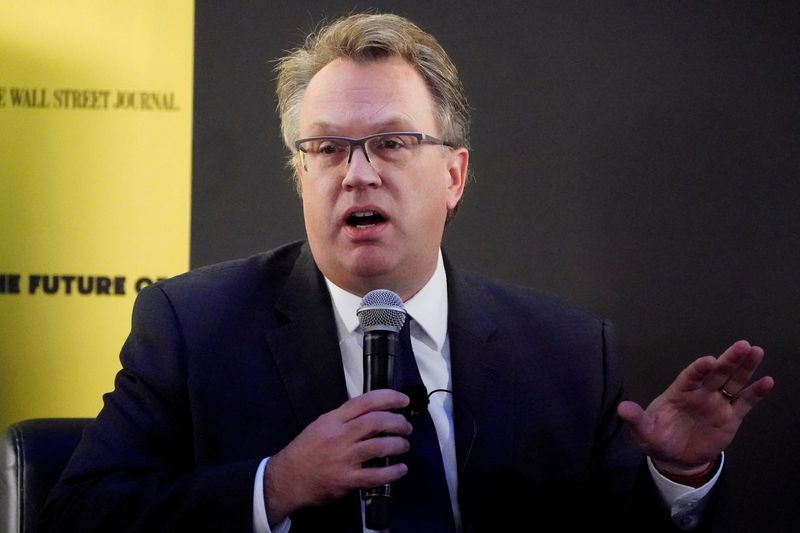Fed’s Williams douses Wall Street’s rate-cut speculation
2023.12.15 16:19

© Reuters. FILE PHOTO: John Williams, Chief Executive Officer of the Federal Reserve Bank of New York, speaks at an event in New York, U.S., November 6, 2019. REUTERS/Carlo Allegri/File Photo
By Michael S. Derby and Howard Schneider
(Reuters) -Just days after a Federal Reserve meeting that penciled in an ample course of interest rate cuts next year, which in turn unleashed a broad rally in financial markets, one of the U.S. central bank’s top policymakers pushed back on the ebullience on Friday.
“We aren’t really talking about rate cuts right now,” New York Fed President John Williams said in an interview with CNBC. When it comes to the question of lowering rates, “I just think it’s just premature to be even thinking about that” as the central bank continues to mull whether monetary policy is in the right place to help guide inflation back to its 2% target, he said.
Williams was the first Fed official to speak in the wake of a policy meeting this week in which the central bank left its benchmark overnight interest rate unchanged in the 5.25%-5.50% range. With rates steady, the big shift in the Fed outlook was tied to projections of an easing of monetary policy next year.
Fed officials’ forecasts collectively priced in three-quarters of a percentage point in cuts in 2024, which would leave the policy rate in the 4.50%-4.75% range by the end of 2024. Those forecasts summarize the views of policymakers and are not an official Fed view, but they are nevertheless closely watched and the numbers helped spur sharp drops in bond yields while driving stock prices up.
In a press conference following the two-day meeting, Fed Chair Jerome Powell on Wednesday acknowledged the shift in views, explained how the forecasts work, while acknowledging “the question of when will it become appropriate to begin dialing back the amount of policy restraint in place, that begins to come into view, and is clearly a topic of discussion out in the world and also a discussion for us at our meeting today.”
‘CLARIFY’ THE MESSAGE
Some market observers saw in Williams’ appearance an attempt to reframe the message that markets took from both the policy meeting and Powell’s comments to reporters.
Williams’ interview appears “intended to lean against speculation on a March cut without ruling it out, and slow the sense in markets of a Fed rush towards cutting following Powell’s very dovish December press conference,” Evercore ISI analysts said.
“Deploying the N.Y. Fed president in this manner is standard practice when the Fed leadership wants to ‘clarify’ the message, but market pricing moved only modestly in response to his comments, reflecting investor conviction that the data is moving in support of earlier/deeper cuts.”
Futures markets briefly fluttered in the wake of Williams’ comments but continued to settle on March as the point at which the central bank will start cutting rates. CME Group’s (NASDAQ:) FedWatch Tool maintained a strong probability of a March cut, with views fragmented on the path of cuts after that.
In an interview with Reuters later on Friday, Atlanta Fed President Raphael Bostic also presented a monetary policy outlook partially at odds with the market’s stance, projecting the possibility of a rate cut in the third quarter of next year.
Bostic, who will be a voting member of the central bank’s policy-setting Federal Open Market Committee in 2024, said he thought inflation, as measured by the personal consumption expenditures price index, would end next year at around 2.4%, which would be enough progress towards the Fed’s 2% target to warrant two quarter-percentage-point rate cuts during the second half of 2024.
When it comes to easing, “I’m not really feeling that this is an imminent thing,” Bostic said, with policymakers still needing “several months” to accumulate enough data and confidence that inflation will continue to fall before moving away from the policy rate’s current range.
Meanwhile, in an interview with the Wall Street Journal, Chicago Fed President Austan Goolsbee said it is increasingly likely the central bank will need to shift its attention from inflation to employment, the other part of its dual mandate. He also told the newspaper he wouldn’t rule out a rate cut in March.
Against all the talk around the prospect of lowering rates, Williams reminded markets that the Fed could still go the other way.
When it comes to the economy, “the base case is looking pretty good: Inflation is coming down, the economy remains strong and unemployment is low.” That said, “one thing we’ve learned, even over the past year, is that the data can move in surprising ways,” he said, adding “we need to be ready to move further if inflation, the progress of inflation were to stall or reverse.”








